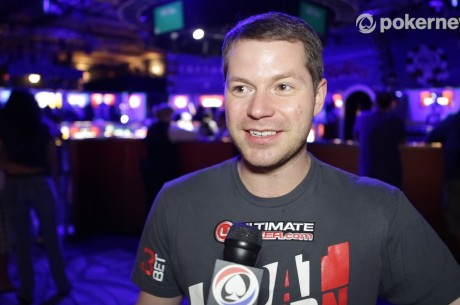Strategy: Analyzing Steve Gee's River Bluff at the 2013 WSOP Main Event

OneBillionHands.com does in-depth analytics for poker, using a massive hole-card-up database. To learn more about the data, check out the OneBillionHands.com site.
One of the most interesting hands during last week��s World Series of Poker broadcast on ESPN occurred when hyper-aggressive Steve Gee found himself chasing a second-best draw.
A recap of the action:
Blinds were 30k/60k with a 10k ante. Jaime Kaplan (3.225m in chips) raised to 130k from middle position with A?10?. Gee (3.045m) called on the button with K?Q?.
Flop: 3?3?7?
Kaplan bet 170k, and Gee called.
Turn: 9?
Kaplan bet 240k, and Gee called.
River: 6?
Kaplan bet 400k, Gee raised to 1.1m, and Kaplan folded.
We conducted an analysis to dive into two of the central questions for this hand:
On the flop, should Steve Gee have chased a non-nut draw on a paired board?
Thanks to the hole card cams, we know that Gee was chasing a draw that would have left him crippled. But Gee couldn��t have known that, and it��s unfair to judge his call based on his 20% equity against Kaplan��s actual hand. The real question is how Gee��s hand looked against the range of hands Kaplan might reasonably have.
To get a sense for how Gee looked against Kaplan��s range, we searched our database for all the players that had been in Gee��s flop situation. Every time we found one, we added his/her opponent��s actual hand to ��Kaplan��s range,�� keeping track of how many times each hand showed up. Then we calculated Gee��s equity against that range.
It turns out that Gee was a 52% favorite! And if Gee had a read on Kaplan, that��s probably a lowball estimate. All in all, very easy to see that Gee��s flop call makes a lot of sense.
Was Gee lucky to win that pot with a bluff on the river?
Again, thanks to the hole card cams, it looked like Gee had a soul-read on Kaplan. But that��s not necessarily the case. Kaplan will often be betting for value hands that are stronger than his busted flush draw.
Our analyses show that Gee��s betting line usually indicates enormous strength. Across all players with a call-call-raise line on a board like this, the river raise was a bluff less than 20% of the time. And if we drop the ��board like this�� qualification, a call-call-raise line is a bluff only 10% of the time!
Overall, Gee��s river raise is extremely credible. It��s a bluff so infrequently that he probably expected to induce a fold from many legitimate hands Kaplan would be betting.
Just how skillful was Steve Gee in this hand?
Gee��s successful river bluff earned him about 23 big blinds relative to the typical player in his shoes.
For more poker strategy, make sure to tune in every week for new episodes of the Strategy with Kristy podcast. Feel free to send in questions, ideas or suggestions for the podcast to [email protected]. Also remember to follow PokerNews on Twitter for up-to-the-minute news.








